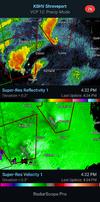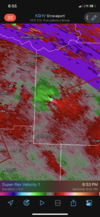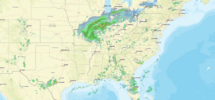Belle Lechat
Member
- Joined
- Aug 29, 2021
- Messages
- 1,529
- Reaction score
- 1,215
Radar indicated rotation
* TORNADO WARNING FOR...
SOUTHWESTERN NATCHITOCHES PARISH IN NORTHWESTERN LOUISIANA...
* UNTIL 245 PM CDT.
* TORNADO WARNING FOR...
WEST CENTRAL DE SOTO PARISH IN NORTHWESTERN LOUISIANA...
SOUTHWESTERN CADDO PARISH IN NORTHWESTERN LOUISIANA...
NORTHEASTERN PANOLA COUNTY IN NORTHEASTERN TEXAS...
* UNTIL 230 PM CDT.
* TORNADO WARNING FOR...
SOUTH CENTRAL HARRISON COUNTY IN NORTHEASTERN TEXAS...
CENTRAL PANOLA COUNTY IN NORTHEASTERN TEXAS...
* UNTIL 230 PM CDT.
* TORNADO WARNING FOR...
CENTRAL DE SOTO PARISH IN NORTHWESTERN LOUISIANA...
WESTERN RED RIVER PARISH IN NORTHWESTERN LOUISIANA...
WEST CENTRAL NATCHITOCHES PARISH IN NORTHWESTERN LOUISIANA...
NORTH CENTRAL SABINE PARISH IN NORTHWESTERN LOUISIANA...
* UNTIL 230 PM CDT.
* TORNADO WARNING FOR...
NORTHWESTERN NEWTON COUNTY IN SOUTHEASTERN TEXAS...
NORTHEASTERN JASPER COUNTY IN SOUTHEASTERN TEXAS...
* UNTIL 230 PM CDT.
* TORNADO WARNING FOR...
SOUTHWESTERN NATCHITOCHES PARISH IN NORTHWESTERN LOUISIANA...
* UNTIL 245 PM CDT.
* TORNADO WARNING FOR...
WEST CENTRAL DE SOTO PARISH IN NORTHWESTERN LOUISIANA...
SOUTHWESTERN CADDO PARISH IN NORTHWESTERN LOUISIANA...
NORTHEASTERN PANOLA COUNTY IN NORTHEASTERN TEXAS...
* UNTIL 230 PM CDT.
* TORNADO WARNING FOR...
SOUTH CENTRAL HARRISON COUNTY IN NORTHEASTERN TEXAS...
CENTRAL PANOLA COUNTY IN NORTHEASTERN TEXAS...
* UNTIL 230 PM CDT.
* TORNADO WARNING FOR...
CENTRAL DE SOTO PARISH IN NORTHWESTERN LOUISIANA...
WESTERN RED RIVER PARISH IN NORTHWESTERN LOUISIANA...
WEST CENTRAL NATCHITOCHES PARISH IN NORTHWESTERN LOUISIANA...
NORTH CENTRAL SABINE PARISH IN NORTHWESTERN LOUISIANA...
* UNTIL 230 PM CDT.
* TORNADO WARNING FOR...
NORTHWESTERN NEWTON COUNTY IN SOUTHEASTERN TEXAS...
NORTHEASTERN JASPER COUNTY IN SOUTHEASTERN TEXAS...
* UNTIL 230 PM CDT.




